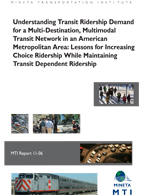- 408-924-7560
- mineta-institute@sjsu.edu
- Donate
Understanding Transit Ridership Demand for a Multi-Destination, Multimodal Transit Network in an American Metropolitan Area
This study examines the factors underlying transit demand in the multi-destination, integrated bus and rail transit network for Atlanta, Georgia. Atlanta provides an opportunity to explore the consequences of a multi-destination transit network for bus patrons (largely transit-dependent riders) and rail patrons (who disproportionately illustrate choice rider characteristics). Using data obtained from the 2000 Census, coupled with data obtained from local and regional organizations in the Atlanta metropolitan area, we estimate several statistical models that explain the pattern of transit commute trips across the Atlanta metropolitan area.
The models show that bus riders and rail riders are different, with bus riders exhibiting more transit-dependent characteristics and rail riders more choice rider characteristics. However, both types of riders value many of the same attributes of transit service quality (including shorter access and egress times and more direct trips) and their use of transit is influenced by many of the same variables (including population and employment). At the same time, the factors that influence transit demand vary depending on the type of travel destination the rider wishes to reach, including whether it is the central business district (CBD) or a more auto-oriented, suburban destination.
The results of the study offer new insights into the nature of transit demand in a multi-destination transit system and provide lessons for agencies seeking to increase ridership among different ridership groups. The results suggest that more direct transit connections to dispersed employment centers, and easier transfers to access such destinations, will lead to higher levels of transit use for both transit-dependent and choice riders. The results also show that the CBD remains an important transit destination for rail riders but not for their bus rider counterparts. Certain types of transit-oriented development (TOD) also serve as significant producers and attractors of rail transit trips.
GREGORY THOMPSON, PhD
Gregory Thompson is Professor of Urban and Regional Planning at Florida State University. He received his PhD at University of California, Irvine. His primary research interest is studying the role of public transportation in auto-dominated societies, both historically and in the present day. He has held professional positions as a transportation planner at both the metropolitan and state levels, in both this country and abroad.
JEFFREY BROWN, PhD
Jeffrey Brown is Associate Professor of Urban and Regional Planning at Florida State University. He received his PhD at University of California, Los Angeles. His research examines the role of public transportation in decentralized environments, the relationship between finance and transportation planning, and the history of transportation planning.
TORSHA BHATTACHARYA
Torsha Bhattacharya is a doctoral candidate at Florida State University. Her research interests include transportation systems, the relationship between transportation and land use, and equity in transportation. She is also interested in research geared towards improving accessibility for disadvantaged groups.
MICHAL JAROSZYNSKI
Michal Jaroszynski is a doctoral student at Florida State University. His research interests include the economic aspects of public transportation, such as assessing costs and benefits or finding the methods of improving its efficiency and productivity. He is also interested in analyzing policies related to public transit service planning, especially rail and multimodal transit systems.
-
Contact Us
SJSU Research Foundation 210 N. 4th Street, 4th Floor, San Jose, CA 95112 Phone: 408-924-7560 Email: mineta-institute@sjsu.edu






